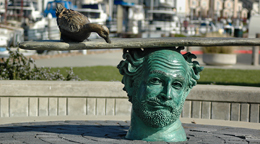Filled with friendly merchants and lively music, world-famous artists and palate-pleasing cuisine, Benicia, just 37 miles from downtown San Francisco, is one of the worst-kept secrets in the heart of the Bay Area.

A bronze statue by local and nationally-known artist, Robert Arneson, stands in the Benicia marina.
By TS Owen
Published: March, 2006
Filled with friendly merchants and lively music, world-famous artists and palate-pleasing cuisine, Benicia, just 37 miles from downtown San Francisco, is one of the worst-kept secrets in the heart of the Bay Area.
Its citizens are dedicated to preserving its rich heritage, as more and more visitors stroll First Street, stopping to shop at buildings steeped in the history of three centuries. Walking guides describe the unique sidewalk tiles and dozens of 19th Century buildings and museums that commemorate the cityís colorful past, the modern spas, and spots to sip tea or enjoy a full repast at the restaurants lining the street where local legend says the secret of gold at Sutterís Mill was first spilled.
Past the pristine First Street Green and imposing Promenade - center of parades and community parties - is a fishing pier and public restroom. This is Benicia Point, where once Pony Express riders galloped and intercontinental trains rolled onto the worldís largest ferry to cross the Carquinez Strait. Californiaís third and only, still standing capitol boasts top hats and local newspapers from the 1853-4 legislative session. While up in the hills, the Benicia Arsenal has some of the finest examples of the stonecutters art in the sandstone buildings of the Benicia Historical Museum, the Clocktower building and the Jefferson Street and Commandantís mansions. A tour of the Arsenalís colony of renowned artists and glassblowers is a rare treat.
Benicia abounds in the authentic and boasts award-winning shops and heart-pleasing sunsets reflected in the Carquinez Strait. Nestled between two bridges with a port and marina, it perches on the waterfront; its beaches and watersports adding to its unique character, which is celebrated in the annual Waterfront Festival. It is a rare and genuine city that has retained its antiques and a unique place in California history.
The phoenix of Bay Area cities, Benicia is proof of the adage: If at first you donít succeed, try, try again. Plans to be the premier deep water port on the west coast, the capitol of the state, a manufacturing hub, the Athens of the West with abundant schools and colleges, and an important military arsenal were all big dreams that turned to pipelines, that is, in the form of the 25-year-old oil refinery, the crown jewel of a thriving industrial park that fuels the economy while downtown attracts visitors.
Main Street has been an integral part of preserving that past while revitalizing the spirit of the founders of this once-bustling rival to San Francisco, encouraging celebratory events such as Benicia in Bloom in April, artistsí open houses in May and December, the Mardi Gras Festival and Arts in the Park, the Peddlerís Fair and Handicraft Festival; and sponsoring Farmers Markets, First Fridays on First and the Waterfront Festival, plus parades from the Fourth of July to Christmas. The efforts have been noticed. Nick Jr. Family Magazine named Benicia one of the most playful cities in America, with its First Fridays on First, street banners designed by local school children, camel races, the Holy Ghost parade, plus, a plethora of parks and outdoor activities.
Recognized for its outstanding schools, unique shopping district, community spirit and world-famous artists, the City on the Strait is low in crime and high in charm. Called quaint by some, it was named one of the Best Places to Live on the Coast by Coastal Living Magazine in 2005, one of the Top 10 Arts Destination Cities in America in a readerís poll in AmericanStyle Magazine in June 2005, one of the Great American Towns in CNN/Money Magazine in July and featured as a North Bay Getaway in December in Sunset Magazine. The Downtown Tea Room was named a leader in the trendy new tea market by VIA Magazine in January-February 2006.
The New York Times named Benicia a top place for antiquing, and the San Francisco Chronicle a number one place to raise a family as well as a one of 15 Good Hoods for being hipper, cheaper and more neighborly than anyone knew.
What remains is a pristine slice of Californiaís colorful past from the Gold Rush to Jack Londonís Fish Patrol that still bustles with new development both downtown and in the hills. Not exactly as its founders envisioned when they named it after the wife of the last Mexican commandant and made it the second city incorporated in the new state of California, but a modern jewel nonetheless.


